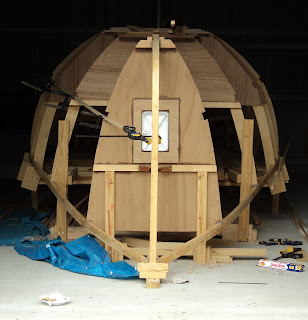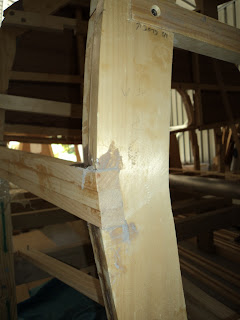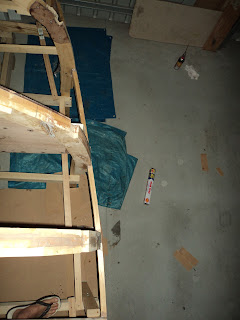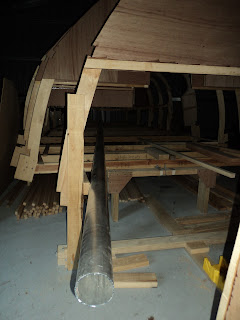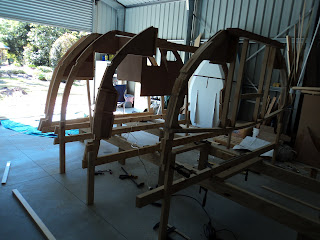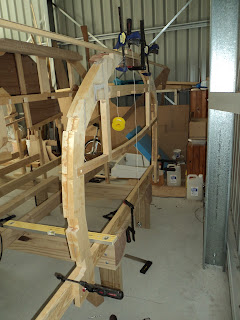For those that came in late, each of the main stringers (I'll call them how I see them now on the building jig, top, middle and bottom) are made from three pieces of 20 mm x 25 mm clear hoop pine laminated together. This gives a final piece 60mm wide let into the frames a minimum of 25mm.
In between each of those goes two evenly spaced smaller stingers, two 20mm x 25mm so only 40mm wide. I scarf cut and joined wood to make the first four pieces that are full length. Then I had to mark out and cut the notches in each frame for them.
To do this I measured the distance between each of the main stringers and marked the frames. Then I got the straightest of the four and lay it along the frames so that it sat on each of the marks. A few minor adjustments and I could mark out the bottom of the notches. I used a metal rule to take the angle of the stringer looking from the side and marked a line on each frame, and carried it around onto the the fore and aft face of each frame. Then using the stringer as a guide measure the distance you need to let the stringer into the frame to maintain the curve and mark it. One side will be 25mm where the edge of the frame touches the stringer, the other will be more to allow the stringer to curve in.
Remove the stringer and use two pieces of the wood to mark the top lines, carry the lines around the side and mark the 'let in' measurement up and you have your notch marked. I used a hand saw cutting from the outside towards the centreline and followed the lines. It seemed to work okay, make sure you are checking each side of the frame as you cut as they are not the same depth front and back.
Now do this so you end up with 78 notches marked (don't count them until you have finished) all hand sawn to the correct depth and angle. I decided to mark and cut them all first before fitting any stringers, it just felt more efficient as I was into the swing of marking out.
Feel free to curse, particularly when you lean in to check a measurement and bang your head on the middle main stringer or crack your shins on the bottom one.
Using a chisel carefully take out the waste material working from each side. The cuts will prevent the frame wood splitting, and some will almost come out with a few hits from each side. You will be surprised how angled rear to front the final result is towards frames 1, 2 and 3.
Below is part way done, note the extra depth to be taken out on the forward side of the frames (up to 30-35mm in on the very front ones to allow the curve. If you look closely on frame two, three and four right hand side you will see that the notches are waiting for cutting, chisel work and finishing.
The below shot is a close up of the side to show hopefully the different depths:
And a final shot from the front:
Next update should show the inbetween stringers in place, things should move along a bit quicker but after the Christmas break.
Thursday, 13 December 2012
Saturday, 17 November 2012
Stringers continue
Slowly but surely moving along. I am only scarfing together long bits six at a time (three each side) as I move up and adjusting the notches takes a bit of time.
Finished the lowest ones (while upside down), someone pointed out it is the most important one as it defines the visible line of the edge of the deck. I should have started at the top (under water) then the middle and the most important one last as I got into it. I still have four each side between the main ones so too late now.
First one finished:
Middle one first piece:
Middle one side done, first on the other:
Below is the middle one finished, on the top left hand side the first one on the chine to bottom stringer is done.
Finished the lowest ones (while upside down), someone pointed out it is the most important one as it defines the visible line of the edge of the deck. I should have started at the top (under water) then the middle and the most important one last as I got into it. I still have four each side between the main ones so too late now.
First one finished:
Middle one first piece:
Middle one side done, first on the other:
Thursday, 25 October 2012
Gunwale stringers 1
Started on the gunwale (I think that's what they are called) stringers.
First thing to do was join my wood to make it long enough. For that I made up a saw jig which fits the wood inside tightly, with an 1:8 angle across cut to fit the saw. Pictures will explain it:
Below is the jig from scrap looking from above
This is cutting the scarf to make the join:
And below is a close up of the end result:
Once I had six long bits, adjusted the cut outs on the frame and epoxied three on one side all in together at once. What a nightmare trying to force three pieces together, bend them and clamp them by myself while the epoxy in the pot goes off. I ended up chucking most of the first lot of epoxy and having to make up a second lot.
This is the final result of the first one:
First thing to do was join my wood to make it long enough. For that I made up a saw jig which fits the wood inside tightly, with an 1:8 angle across cut to fit the saw. Pictures will explain it:
Below is the jig from scrap looking from above
This is cutting the scarf to make the join:
And below is a close up of the end result:
Once I had six long bits, adjusted the cut outs on the frame and epoxied three on one side all in together at once. What a nightmare trying to force three pieces together, bend them and clamp them by myself while the epoxy in the pot goes off. I ended up chucking most of the first lot of epoxy and having to make up a second lot.
This is the final result of the first one:
For the second side I have decided to change tactics. Seemed much quicker adjusting the cut outs in
the frames, but I have the first ones to measure off to see how much to take
off. Decided to epoxy the lowest one on
alone first, making sure it follows the marks on the frame. The other two will then be dropped in together
on top over the day or two when I get the chance.
From the front with the second side epoxied and clamped in place:
Saturday, 13 October 2012
Started on the chines - method
Each of the main stringers, the front to back bits that fit in the frames and give the hull support and shape until finished, is made up of three pieces of 20mm x 25mm Clear Hoop Pine. The designer said it was easier to laminate them in place from three pieces rather than try and bend a 60mm x 25mm piece of wood around the curves. Having started on the first one, I believe him.
There are three main ones each side. The top and bottom, and a middle one which is located where the two curved sections meet. It will become clear hopefully as the photos and chines go on.
There are also two small ones which run from the back of the cabin to the transom, and change the top (when right way up) curve into a straight side. Basically the hull section has no curve above this little "tumblehome" (I think) stringer to the top of the hull, it is a straight line and actually ends inboard of the curved hull below it. On the below photo, from the centre stringer piece to the bottom is straight (boat upside down still), above that is curve up to the middle full length stringer.
It also had the advantages of being short, and wouldn't be seen by anyone as it will be inside and underneath the cockpit when finished. A perfect one to learn on!
I will explain the process, then as subsequent stringers go on I will stick to photos and brief descriptions. To fit the stringer it is necessary to:
1. Using a single piece of wood first, adjust the cut outs on each frame so that the stringer forms an even curve. I initially was using a chisel, but got a rough wood file which seems to work much better. You really only need to take extra wood off the frame edge on one side where the stringer touches it. Trust me this involves putting the wood on and off a hundred times until you think it is right.
Below you can see how the right hand part of the frame was adjusted as the wood curves in on that side.
2. Once you have the first one on, I put the second and third on together and got them to line up with the first which was clamped in place separately as a guide.
3. Once all three are on, pull them all off and epoxy glue them on. I glued the first (bottom one) on by itself and then the top two together. Final adjustments with the use of many clamps, including making sure that all three lined up vertically and horizontally.
Below you can see the clamps holding the pieces together in each direction.
Once all the stringers are on it will still be necessary to taper part of it to match the change in hull curve. It is a bit hard to see, but the very top of the three stringers is a couple of mm outside the curve and will be sanded to match the curve above it shown by the frame. From the middle stringer piece to the bottom of the photo should be a straight line with no curve.
Some wider shots. All clamped on and glued:
From the side:
From above:
Finished with the ends trimmed:
There are three main ones each side. The top and bottom, and a middle one which is located where the two curved sections meet. It will become clear hopefully as the photos and chines go on.
There are also two small ones which run from the back of the cabin to the transom, and change the top (when right way up) curve into a straight side. Basically the hull section has no curve above this little "tumblehome" (I think) stringer to the top of the hull, it is a straight line and actually ends inboard of the curved hull below it. On the below photo, from the centre stringer piece to the bottom is straight (boat upside down still), above that is curve up to the middle full length stringer.
It also had the advantages of being short, and wouldn't be seen by anyone as it will be inside and underneath the cockpit when finished. A perfect one to learn on!
I will explain the process, then as subsequent stringers go on I will stick to photos and brief descriptions. To fit the stringer it is necessary to:
1. Using a single piece of wood first, adjust the cut outs on each frame so that the stringer forms an even curve. I initially was using a chisel, but got a rough wood file which seems to work much better. You really only need to take extra wood off the frame edge on one side where the stringer touches it. Trust me this involves putting the wood on and off a hundred times until you think it is right.
Below you can see how the right hand part of the frame was adjusted as the wood curves in on that side.
2. Once you have the first one on, I put the second and third on together and got them to line up with the first which was clamped in place separately as a guide.
3. Once all three are on, pull them all off and epoxy glue them on. I glued the first (bottom one) on by itself and then the top two together. Final adjustments with the use of many clamps, including making sure that all three lined up vertically and horizontally.
Below you can see the clamps holding the pieces together in each direction.
Once all the stringers are on it will still be necessary to taper part of it to match the change in hull curve. It is a bit hard to see, but the very top of the three stringers is a couple of mm outside the curve and will be sanded to match the curve above it shown by the frame. From the middle stringer piece to the bottom of the photo should be a straight line with no curve.
Some wider shots. All clamped on and glued:
From the side:
From above:
Finished with the ends trimmed:
Mast done for now
I have finished for now with the mast. The three pieces bottom, pipe and upper will be connected by two cross pieces of 6mm threaded rod at each join. This will make a mast 9800mm long, so I am in no hurry to finish. Painted them all and here is the final shots, firstly from a distance:
Then a close up of the bottom piece and boom jaw support platform (just sitting there)
And two shots of the 6500mm long tube, first showing the 3mm wall thickness:
And then a shot of it full length. It goes from nearly bulkhead one to the transom!
And two shots of the 6500mm long tube, first showing the 3mm wall thickness:
And then a shot of it full length. It goes from nearly bulkhead one to the transom!
Gaff and Boom Part 2
Managed to keep going with the gaff and boom. Once the boom jaws were finished I painted the whole thing and attached the jaws with three 8mm galvanised cup head bolts.
Below is a close up from below, there still needs to be leather around the inside but I will get to that:
And from a distance. Overall length is 4250mm plus the end of the jaws, but is surprising how light it is.
Then I followed the same process with the gaff. First I cut and shaped the jaws, this time from Qld Silver Ash hardwood. Then a cut in the main part for a pivot piece (3mm plate).
Below is with them sitting in place yet to be attached, a curve was also made in the end of the gaff.
And an overall shot, length is 3300 plus jaws.
Below is a close up from below, there still needs to be leather around the inside but I will get to that:
And from a distance. Overall length is 4250mm plus the end of the jaws, but is surprising how light it is.
Then I followed the same process with the gaff. First I cut and shaped the jaws, this time from Qld Silver Ash hardwood. Then a cut in the main part for a pivot piece (3mm plate).
Below is with them sitting in place yet to be attached, a curve was also made in the end of the gaff.
And an overall shot, length is 3300 plus jaws.
Tuesday, 25 September 2012
Gaff and Boom Part 1
Before starting the mast I had laminated the Oregon for the
boom and gaff. Below is the gaff being laminated from 60mm x 30mm Oregon with
a little shaping, 3300mm long plus jaws.
The boom is 4250mm long plus the jaws, two laminations of 90mm x 32mm Oregon
cut to shape.
I drew and cut the boom jaws from spotted gum.
Then drilled the boom to suit. Below is dry fit only, to be bolted with 3 9mm bolts and some leather on the jaws after that. The gaff jaws are still to come.
Back from a break - Mast started
I have had a little
break, putting the frames up went much quicker than I thought and had to order
more wood for the chines. This is all 25mm x 20mm, but I now have to
scarf/join them all together so I end up with 34 pieces each around 8m long
before I can start fitting them to the frames. That part has me a bit
worried, the build guide says take your time because the hull will show the
bumps if you don't.
So I decided to make
something else instead. Ordered some Oregon Pine, some spotted gum
hardwood and away I went. The main section of the mast was ordered and
delivered, a 100mm diameter, 3mm wall thickness tube of marine alloy
6500mm long. It weighs 16kg, and is easily carried by myself, and makes
the whole thing a lot easier to build.
The top and bottom pieces are hollow
to save weight. For example, to make the bottom get two pieces of
120mm x 40mm and sandwich two 40mm x 40mm pieces each side leaving the centre
40mm x 40mm space empty. For the top you use 100mm x 30mm.
But you need to add strength in
places and to cap the top and bottom. This requires extra 40mmx 40mm
pieces in the otherwise empty middle. The top and bottom, and where
important strength is required you add 40mm x 40mm pieces, 400mm long for mast
fittings and the mast pivot at the bottom. The end result is two semi
hollow boxes, the bottom 120mm square and the top 100mm square.
Overall length of the
mast is 9800mm which is longer than my shed.
Below is the base of the
bottom piece, that will have a pivot fitted and go into the tabernacle (800mm
high metal mast support on deck):
And showing the length.
And after final shaping. I cut down the upper section to fit inside the alloy tube, it is 1200mm to the flat surface the tube will rest on. The outside hardwood pieces (small) are vertical legs for the boom support (see later photos).
The top wooden piece is 2400mm long, 300mm of that to go inside the tube. There are two positions for rigging hardware, so it maintains the 100mm width for strength for the first 800mm. However I planed large sections off the corners to end up with a hexagon shape, I was too lazy to go for a circle and the added benefit I see is a flat surface to bolt the rigging fittings through both sides. The final 1300mm tapers from a 100mm wide hexagon to a 70mm square
I was adding internal plugs for the top and bottom, and supports at each of the two rigging places so I decided to make some adjustments.
As I needed to run wiring down the mast, I planed a corner
off each of the inserts to leave a space for this.
I also cut the tops of each insert on an angle down to the gap, thinking that any water that gets in through the mast top or rigging bolts will run down and eventually out where the bottom of the pipe meets the wooden base where the electrical wire will run.
Below is the view down from the top.
Epoxy it all together:
A bit of sanding on the inserts to get them sliding into the tube and then on to finish the boom support. Below is 3 layers of 9mm ply that will be screwed to the small hardwood uprights shown earlier.
.
Sunday, 19 August 2012
Lessons learnt from frames to strongback
I will add to this as I think of more but so far:
Follow the plans exactly - I saved some wood by not continuing the solid frame sides up higher to attach the temporary cross piece. This cost me lots of time, heartache and extra work in the long run as I had to buy more wood to support them higher.
Mark everything when on the drafting floor - some of the frames I missed the waterline and it was a pain to try and confirm them. It is also an opportunity for errors to occur.
Take your time with the frames - mine worked out fairly well and were level in each direction when they came off the floor. This makes it much easier when the time comes to line them all up, and it helps your confidence no end when things start to go right.
Measure twice, cut once - everyone knows this one, thankfully I only had to remake the solid wood for one frame.
Closely related is measure twice, screw once - as I was standing up the frames and moving them up and down each side I lost count of the times I had to remove screws because I had forgot to check something. Get it where you think it needs to be, then double check EVERYTHING before you screw it in place.
Standing up the frames - lots of clamps and take your time. Start with the centreline on the frame matching the centreline on the strongback. I used wire down the strongback for the centreline, then string and a weight to get the frame in the right spot. Use string from the centreline out to the sides of the frame to confirm they are at 90 degrees (the length of the string should be the same).
Keep your level close to hand - always keep checking levels in each direction. A little move one way can throw out other parts of the frame.
Don't forget to duck and lift your feet - as you move side to side and through the frames there are very hard pieces of wood at shin height and also some plywood stuff just at head height out of view. Trust me, it hurts!
Eat and Hydrate - keep water close at hand and drink often. Sounds simple but several times I got lost in the work and realised at the end of the day I was very thirsty. I also found sometimes I needed to walk away and have a break when things were not going well. Plus you get to look at what you have achieved so far which keeps the motivation up.
Follow the plans exactly - I saved some wood by not continuing the solid frame sides up higher to attach the temporary cross piece. This cost me lots of time, heartache and extra work in the long run as I had to buy more wood to support them higher.
Mark everything when on the drafting floor - some of the frames I missed the waterline and it was a pain to try and confirm them. It is also an opportunity for errors to occur.
Take your time with the frames - mine worked out fairly well and were level in each direction when they came off the floor. This makes it much easier when the time comes to line them all up, and it helps your confidence no end when things start to go right.
Measure twice, cut once - everyone knows this one, thankfully I only had to remake the solid wood for one frame.
Closely related is measure twice, screw once - as I was standing up the frames and moving them up and down each side I lost count of the times I had to remove screws because I had forgot to check something. Get it where you think it needs to be, then double check EVERYTHING before you screw it in place.
Standing up the frames - lots of clamps and take your time. Start with the centreline on the frame matching the centreline on the strongback. I used wire down the strongback for the centreline, then string and a weight to get the frame in the right spot. Use string from the centreline out to the sides of the frame to confirm they are at 90 degrees (the length of the string should be the same).
Keep your level close to hand - always keep checking levels in each direction. A little move one way can throw out other parts of the frame.
Don't forget to duck and lift your feet - as you move side to side and through the frames there are very hard pieces of wood at shin height and also some plywood stuff just at head height out of view. Trust me, it hurts!
Eat and Hydrate - keep water close at hand and drink often. Sounds simple but several times I got lost in the work and realised at the end of the day I was very thirsty. I also found sometimes I needed to walk away and have a break when things were not going well. Plus you get to look at what you have achieved so far which keeps the motivation up.
Frames standing up
With the assistance of an extra day off for the local show in Brisbane, and a rostered day off I had some solid shed time to get the frames up. I will do another post after this one with the lessons learnt for those considering a build in the future.
But now time to gloat!
Started with frames 4 (galley front) and 5 (galley rear) as per the building instructions from John Welsford. I spent extra time getting the frames at the right height from the strongback (1106mm) as all the waterlines etc are taken from here. Once they were stood up you screw the 12mm ply galley front bottom piece (which is the top when you build upside down!) to stiffen the two frames.
And from the side with frame 3 in front:
Then I worked back from frame 5 to the transom. Each frame was levelled vertically, horizontally and using a string and nail from the centreline was positioned at 90 degrees to the centreline (hopefully). Below is 3 - 7:
Fr 3 - 7 from the front side:
Continue on to the transom which is actually 15mm above the waterline (below when building upside down) hence the packer under my string line to get levels right at the sides. In front you can see frame 10 and 9 which is the solid one:
And from the side:
Once I got the transom done it was time to dynabolt the wooden ground supports for the stem and frames 1 -2:
Then I stood up frames 1 - 2:
You will see in the below photo some extra legs. One of the lessons learnt is to follow the plans exactly. Some of my frames needed to be raised above the cross pieces, but this actually worked out well because I could put in a vertical leg to take some of the weight and also support the frames:
Then this morning it was finish attaching frame 1, then cut the stem and glue. This took much longer than I thought. Below is the cut down stem:
Glued in place:
And from the side:
And now, the final results. Thanks to digital photos I can spin them round to right way up for the internal shots.
From a distance from the front:
Inside from fr 8 towards fr 1:
Frame 5 - 1 inside
But now time to gloat!
Started with frames 4 (galley front) and 5 (galley rear) as per the building instructions from John Welsford. I spent extra time getting the frames at the right height from the strongback (1106mm) as all the waterlines etc are taken from here. Once they were stood up you screw the 12mm ply galley front bottom piece (which is the top when you build upside down!) to stiffen the two frames.
And from the side with frame 3 in front:
Then I worked back from frame 5 to the transom. Each frame was levelled vertically, horizontally and using a string and nail from the centreline was positioned at 90 degrees to the centreline (hopefully). Below is 3 - 7:
Fr 3 - 7 from the front side:
Continue on to the transom which is actually 15mm above the waterline (below when building upside down) hence the packer under my string line to get levels right at the sides. In front you can see frame 10 and 9 which is the solid one:
And from the side:
Once I got the transom done it was time to dynabolt the wooden ground supports for the stem and frames 1 -2:
Then I stood up frames 1 - 2:
You will see in the below photo some extra legs. One of the lessons learnt is to follow the plans exactly. Some of my frames needed to be raised above the cross pieces, but this actually worked out well because I could put in a vertical leg to take some of the weight and also support the frames:
Then this morning it was finish attaching frame 1, then cut the stem and glue. This took much longer than I thought. Below is the cut down stem:
Glued in place:
And from the side:
Once they were all up, I went along and nailed them to each other, across the tops and back to the strongback in a few places. This took a while as I was checking everything again, below shows the ones across the top, the earlier photo of the legs shows one of the angle ones in the background:
From a distance from the front:
Inside from fr 8 towards fr 1:
Frame 5 - 1 inside
Frame 6 to the transom:
Now have to organise the wood for the stringers.
Subscribe to:
Comments (Atom)




